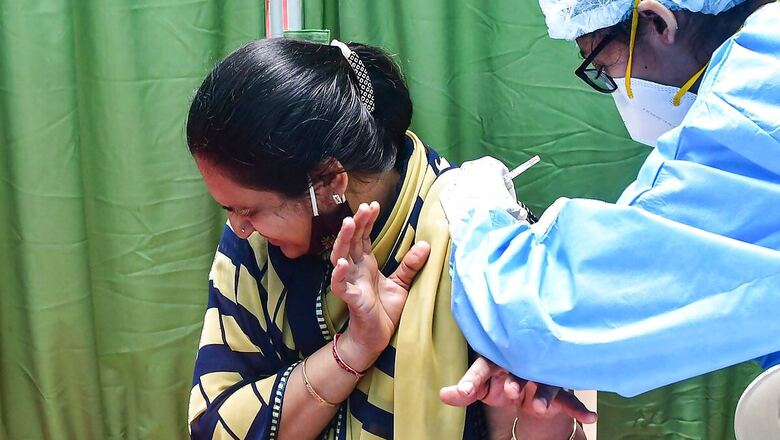
views
In a setback to the country’s efforts to defeat the COVID-19 pandemic, the current pace of vaccination has seen a big drop despite the fact that 50 per cent more vaccine doses have been administered under the new vaccination policy that begin on June 21 as compared to the first 20 days of the last month.
A total of 9,14,64,483 doses were administered between June 21 to July 10, which were 3,05,57,717 doses more than 6,09,06,766 lakh doses administered in the 20 days between June 1 and June 20. The 20 days, on an average, saw 45,73,224 COVID-19 vaccine doses being daily.
But when we see the five-day average of vaccinations, we see an almost consistent decline.
A total of 3,27,23,427 doses were administered between June 21 to 25 with an average of 65,44,685 doses per day. June 21, in fact, saw the peak of vaccination so far with 86,16,373 vaccine doses administered.
The pace of vaccination came down by 39 per cent between June 26 to 30. 1,98,35,946 doses were administered in this period with an average of 39,67,189 doses per day. It slightly went up, by 6 per cent between July 1 and July 5 when 2,11,15,099 doses were administered with an average of 42,23,019 doses a day. But the pace again came down by almost 16 per cent in last five days, between July 6 and July 10.
When we compare the first five-day cumulative figure with the last five days, we see a massive decline of 45.6 per cent.
When coupled with the rapid surge in R value, it seems, we are looking at difficult days ahead in next months.
Surge in Covid R-Number from June-End:
R value or the reproductive number or the effective transmission rate here tells how fast coronavirus spreads from one to next person. Analysed by a team of researchers, led by Sitabhra Sinha from the Institute of Mathematical Sciences in Chennai since the beginning of the pandemic in India, R value must be less than one for the pandemic to end.
According to reports published in the ‘The Print’, Sinha said India’s R value came below 1, at 0.98, around May 11 and subsequently fell to the lowest point since the beginning of the pandemic, at 0.78 around June 16 from the peak of 1.37 between March 9 to April 11.
But the R value has started rising again with eased lockdown measures and almost non-existent COVID appropriate behavior as confirmed by different media reports. An Indian Express analysis, quoting Sinha’s data, says the R value has gone up, from 0.78 to 0.88 between June 20 and July 7.
Though the R value is still below 1, it could soon cross the mark as the country fears a possible third COVID-19 next month. An SBI Research report says the third COVID-19 wave is expected to arrive in August and the COVID-19 cases are expected to peak in September.
Issuing a warning, AIIMS Director Dr Randeep Guleria has said that lack of COVID appropriate behavior means India could see the third COVID-19 wave in 6 to 8 weeks.
India’s Vaccination Plan:
Vaccination is the only solution to handle the COVID-19 crisis but its speed has slowed down considerably and going by the average of the daily vaccination in the last 20 days of the new COVID drive, the country will have 46.81 crore adults or 88.92 crore of its total population unvaccinated in August.
India is expected to get 216 crore vaccines spread over the rest of the days of this year and aims to vaccinate its entire adult population but the bulk vaccine supply is only expected to begin from August or September month.
The sliding pace of vaccination had forced the state governments to request the Centre to take over the exercise under its control again, as was earlier being followed which started from June 21. The country, prior to it, had followed a decentralised vaccine policy from May to June 20. Under it, states and private hospitals were sharing 50 per cent responsibility of arranging vaccines for the 18-44 age group of the population while the population base above 45 years of age got free vaccines from the Centre.
Read all the Latest News, Breaking News and Coronavirus News here.



















Comments
0 comment